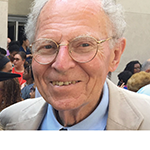Growing up in Brooklyn, N.Y., Paul H. Plotz, MD, often enjoyed an exciting game of stoopball with friends. Young Plotz took turns beaming a ball at the corner of his stoop, stopping occasionally to allow his father’s patients to enter the front door of his house, which also doubled as his father’s office.
Although some argue that the magic of stoopball is unparalleled, Dr. Plotz found that sitting in his father’s consultation area was just as magical. While doing his homework, he overheard his father’s evening phone calls to colleagues and patients. Without knowing what his future would hold, he was subconsciously learning to communicate like a physician.
Years later, Dr. Plotz realized that lessons of good communication between doctors and patients were deeply embedded in him from those days in his father’s office. “When I got to medical school, I realized that this was part of me – this was within me,” he says.

Literary Inspiration
An avid reader of novels, Dr. Plotz began wondering if instructive material could be found within the pages of literature. “Novels – the good ones anyway – tell you about the world; they tell you about human beings and how they interact,” he says. “So I wondered if that was also true for medical interactions. Could one find in literature things that are instructive – that one could use, that one could learn from to supplement general clinical teaching?” With that question was born the 2007 REF Paul Klemperer, MD, Memorial Lecture “The Vocation of Medicine: Lessons from Real and Imagined Doctors.”
Serving as chief of the Arthritis and Rheumatism Branch at the National Institute of Arthritis and Musculoskeletal and Skin Diseases (NIAMS), Dr. Plotz has never stopped learning about interacting with patients. He encourages other physicians to understand that this is every doctor’s subject.
“Most doctors are doctors 24 hours a day, seven days a week from the moment they graduate,” says Dr. Plotz, who believes that one should allow life to teach about human interaction. “Every time one interacts with anybody, one may subconsciously learn a lesson that might inform a clinical situation.”
Although most physicians know best practices in doctor–patient interaction, not every physician has had the opportunity to take an in-depth look at the topic. Those who attend the Klemperer Lecture at this year’s ACR/ARHP Annual Scientific Meeting will see how the vocation of medicine is learned from many non-medical teachers as well as medical ones. Attendees also will see that literature provides fertile and instructive models (both good and bad) of doctor–patient interactions. Dr. Plotz has spent well over a year finding and reading passages that will speak to attendees in a new way. “Many of the passages are from unlikely sources and are – more or less – deeply instructive,” says Dr. Plotz.
Career Focused on a Cure
To Dr. Plotz, being awarded the Klemperer Lectureship is a culmination of years of work in both clinical and research roles. As a NIAMS senior investigator, Dr. Plotz is researching Pompe syndrome, a metabolic disease and phenocopy of myositis. He became more interested in this research when he discovered that Pompe syndrome is part of a family of diseases that may respond to either genetic therapy or replacement of the mutated enzyme.
“Rheumatologists are not famous for curing people – maybe making them feel better and even get better, but cure was something we could only aspire to and not actually achieve most of the time. I thought it would be thrilling to be able to cure a rheumatologic disease, namely Pompe syndrome,” says Dr. Plotz.
After taking an initial look at the mutations and altered proteins in the disease, Dr. Plotz became involved with gene therapy and created several mouse models of the disease, taking him deeper into the research. “The deepest place we have been drawn is into the area of the limit to the response to therapy,” he says. “The therapy that has been developed and approved is not fully satisfactory for the disease as it is in the skeletal muscles. We discovered phenomena that were consequences of the mutation that were unanticipated, quite unexpected, and therapeutically very challenging – not at all the problem that the therapy was designed to treat.”
Currently, Dr. Plotz and his team are exploring the basic problem that leads to this resistance to therapy. He finds this research difficult, yet exciting.
He’s come a long way from his days as a boy in Brooklyn, gaining both clinical and research knowledge along the way. Dr. Plotz will share his thoughts on the vocation of medicine with annual meeting attendees on Saturday, November 10 from 9:15–10:15 a.m. Attendees may even get a few stoopball tips.
